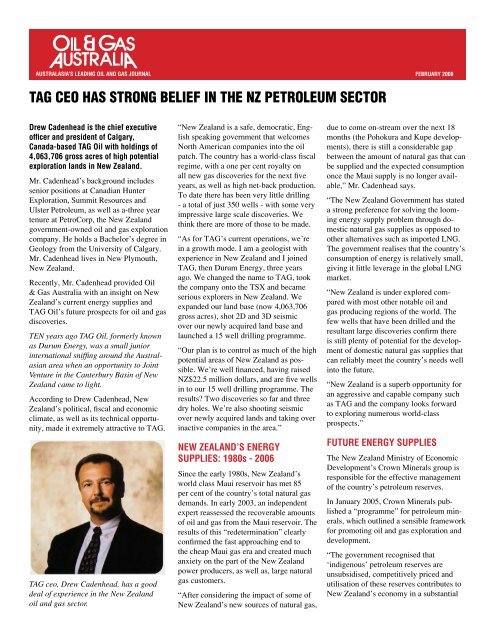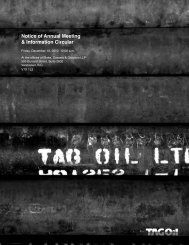tag ceo has strong belief in the nz petroleum sector - TAG Oil
tag ceo has strong belief in the nz petroleum sector - TAG Oil
tag ceo has strong belief in the nz petroleum sector - TAG Oil
Create successful ePaper yourself
Turn your PDF publications into a flip-book with our unique Google optimized e-Paper software.
AUSTRALASIA’S LEADING OIL AND GAS JOURNAL FEBRUARY 2006<strong>TAG</strong> CEO HAS STRONG BELIEF IN THE NZ PETROLEUM SECTORDrew Cadenhead is <strong>the</strong> chief executiveofficer and president of Calgary,Canada‐based <strong>TAG</strong> <strong>Oil</strong> with hold<strong>in</strong>gs of4,063,706 gross acres of high potentialexploration lands <strong>in</strong> New Zealand.Mr. Cadenhead’s background <strong>in</strong>cludessenior positions at Canadian HunterExploration, Summit Resources andUlster Petroleum, as well as a‐three yeartenure at PetroCorp, <strong>the</strong> New Zealandgovernment‐owned oil and gas explorationcompany. He holds a Bachelor’s degree <strong>in</strong>Geology from <strong>the</strong> University of Calgary.Mr. Cadenhead lives <strong>in</strong> New Plymouth,New Zealand.Recently, Mr. Cadenhead provided <strong>Oil</strong>& Gas Australia with an <strong>in</strong>sight on NewZealand’s current energy supplies and<strong>TAG</strong> <strong>Oil</strong>’s future prospects for oil and gasdiscoveries.TEN years ago <strong>TAG</strong> <strong>Oil</strong>, formerly knownas Durum Energy, was a small junior<strong>in</strong>ternational sniff<strong>in</strong>g around <strong>the</strong> Australasianarea when an opportunity to Jo<strong>in</strong>tVenture <strong>in</strong> <strong>the</strong> Canterbury Bas<strong>in</strong> of NewZealand came to light.Accord<strong>in</strong>g to Drew Cadenhead, NewZealand’s political, fiscal and economicclimate, as well as its technical opportunity,made it extremely attractive to <strong>TAG</strong>.<strong>TAG</strong> <<strong>strong</strong>>ceo</<strong>strong</strong>>, Drew Cadenhead, <<strong>strong</strong>>has</<strong>strong</strong>> a gooddeal of experience <strong>in</strong> <strong>the</strong> New Zealandoil and gas <strong>sector</strong>.“New Zealand is a safe, democratic, Englishspeak<strong>in</strong>g government that welcomesNorth American companies <strong>in</strong>to <strong>the</strong> oilpatch. The country <<strong>strong</strong>>has</<strong>strong</strong>> a world‐class fiscalregime, with a one per cent royalty onall new gas discoveries for <strong>the</strong> next fiveyears, as well as high net‐back production.To date <strong>the</strong>re <<strong>strong</strong>>has</<strong>strong</strong>> been very little drill<strong>in</strong>g‐ a total of just 350 wells ‐ with some veryimpressive large scale discoveries. Weth<strong>in</strong>k <strong>the</strong>re are more of those to be made.“As for <strong>TAG</strong>’s current operations, we’re<strong>in</strong> a growth mode. I am a geologist wi<strong>the</strong>xperience <strong>in</strong> New Zealand and I jo<strong>in</strong>ed<strong>TAG</strong>, <strong>the</strong>n Durum Energy, three yearsago. We changed <strong>the</strong> name to <strong>TAG</strong>, took<strong>the</strong> company onto <strong>the</strong> TSX and becameserious explorers <strong>in</strong> New Zealand. Weexpanded our land base (now 4,063,706gross acres), shot 2D and 3D seismicover our newly acquired land base andlaunched a 15 well drill<strong>in</strong>g programme.“Our plan is to control as much of <strong>the</strong> highpotential areas of New Zealand as possible.We’re well f<strong>in</strong>anced, hav<strong>in</strong>g raisedNZ$22.5 million dollars, and are five wells<strong>in</strong> to our 15 well drill<strong>in</strong>g programme. Theresults? Two discoveries so far and threedry holes. We’re also shoot<strong>in</strong>g seismicover newly acquired lands and tak<strong>in</strong>g over<strong>in</strong>active companies <strong>in</strong> <strong>the</strong> area.”NEW ZEALAND’S ENERGYSUPPLIES: 1980s ‐ 2006S<strong>in</strong>ce <strong>the</strong> early 1980s, New Zealand’sworld class Maui reservoir <<strong>strong</strong>>has</<strong>strong</strong>> met 85per cent of <strong>the</strong> country’s total natural gasdemands. In early 2003, an <strong>in</strong>dependentexpert reassessed <strong>the</strong> recoverable amountsof oil and gas from <strong>the</strong> Maui reservoir. Theresults of this “redeterm<strong>in</strong>ation” clearlyconfirmed <strong>the</strong> fast approach<strong>in</strong>g end to<strong>the</strong> cheap Maui gas era and created muchanxiety on <strong>the</strong> part of <strong>the</strong> New Zealandpower producers, as well as, large naturalgas customers.“After consider<strong>in</strong>g <strong>the</strong> impact of some ofNew Zealand’s new sources of natural gas,due to come on‐stream over <strong>the</strong> next 18months (<strong>the</strong> Pohokura and Kupe developments),<strong>the</strong>re is still a considerable gapbetween <strong>the</strong> amount of natural gas that canbe supplied and <strong>the</strong> expected consumptiononce <strong>the</strong> Maui supply is no longer available,”Mr. Cadenhead says.“The New Zealand Government <<strong>strong</strong>>has</<strong>strong</strong>> stateda <strong>strong</strong> preference for solv<strong>in</strong>g <strong>the</strong> loom<strong>in</strong>genergy supply problem through domesticnatural gas supplies as opposed too<strong>the</strong>r alternatives such as imported LNG.The government realises that <strong>the</strong> country’sconsumption of energy is relatively small,giv<strong>in</strong>g it little leverage <strong>in</strong> <strong>the</strong> global LNGmarket.“New Zealand is under explored comparedwith most o<strong>the</strong>r notable oil andgas produc<strong>in</strong>g regions of <strong>the</strong> world. Thefew wells that have been drilled and <strong>the</strong>resultant large discoveries confirm <strong>the</strong>reis still plenty of potential for <strong>the</strong> developmentof domestic natural gas supplies thatcan reliably meet <strong>the</strong> country’s needs well<strong>in</strong>to <strong>the</strong> future.“New Zealand is a superb opportunity foran aggressive and capable company suc<<strong>strong</strong>>has</<strong>strong</strong>> <strong>TAG</strong> and <strong>the</strong> company looks forwardto explor<strong>in</strong>g numerous world‐classprospects.”FUTURE ENERGY SUPPLIESThe New Zealand M<strong>in</strong>istry of EconomicDevelopment’s Crown M<strong>in</strong>erals group isresponsible for <strong>the</strong> effective managementof <strong>the</strong> country’s <strong>petroleum</strong> reserves.In January 2005, Crown M<strong>in</strong>erals publisheda “programme” for <strong>petroleum</strong> m<strong>in</strong>erals,which outl<strong>in</strong>ed a sensible frameworkfor promot<strong>in</strong>g oil and gas exploration anddevelopment.“The government recognised that‘<strong>in</strong>digenous’ <strong>petroleum</strong> reserves areunsubsidised, competitively priced andutilisation of <strong>the</strong>se reserves contributes toNew Zealand’s economy <strong>in</strong> a substantial
AUSTRALASIA’S LEADING OIL AND GAS JOURNAL FEBRUARY 2006New Zealand oil and gas exploration.They <strong>in</strong>clude:• New Zealand <<strong>strong</strong>>has</<strong>strong</strong>> a stable democraticgovernment, which <<strong>strong</strong>>has</<strong>strong</strong>> demonstrateda will<strong>in</strong>gness to promote oil and gasexploration. Even though <strong>the</strong>re was anelection <strong>in</strong> September 2005, both <strong>the</strong>predom<strong>in</strong>ant political parties (Nationaland Labour) have publicly stated <strong>strong</strong>ongo<strong>in</strong>g support for domestic oil andgas exploration.• New Zealand <<strong>strong</strong>>has</<strong>strong</strong>> a superior fiscal regime,with royalties substantially belowo<strong>the</strong>r possible <strong>in</strong>vestment locations withsimilar (very low) political risk profiles.• There is <strong>the</strong> potential for large scalediscoveries as <strong>the</strong> region <<strong>strong</strong>>has</<strong>strong</strong>> not beenexplored to <strong>the</strong> extent that o<strong>the</strong>r regionshave. For example, <strong>the</strong> drill<strong>in</strong>g density<strong>in</strong> <strong>the</strong> Taranaki region is approximatelyone well for every 120,000 acres(compared with one well for every 1500acres across Western Canada). In <strong>the</strong>Canterbury Bas<strong>in</strong> (South Island), <strong>the</strong>drill<strong>in</strong>g density drops to one well every600,000 acres <strong>in</strong> an area that <<strong>strong</strong>>has</<strong>strong</strong>> worldclass prospects.• There <<strong>strong</strong>>has</<strong>strong</strong>> been a three to five fold<strong>in</strong>crease <strong>in</strong> domestic natural gas pricesover <strong>the</strong> past 18 months as a result of<strong>the</strong> dw<strong>in</strong>dl<strong>in</strong>g Maui reserves.• Low operational costs and exist<strong>in</strong>g <strong>in</strong>frastructureaccess results <strong>in</strong> high profitpotential, at least twice what would benormally expected <strong>in</strong> North America.<strong>TAG</strong>’S OBJECTIVES IN NEWZEALANDMr. Cadenhead said <strong>TAG</strong> <<strong>strong</strong>>has</<strong>strong</strong>> developed arisk managed bus<strong>in</strong>ess plan that comb<strong>in</strong>esshallow (less than 2500 metres) lowrisk oil opportunities with deeper (4000metres), high reward gas opportunities.“<strong>TAG</strong> will <strong>in</strong>itially build our reserve andcash flow base on several shallow oiltargets that are drill‐ready now and presentlywait<strong>in</strong>g rig availability. It is expectedthat six to eight of <strong>the</strong>se shallow wells willbe drilled over <strong>the</strong> next 12 to 18 months.These 3D seismically identified prospectsare expected to deliver good results andprovide <strong>strong</strong> cash flow to support fur<strong>the</strong>rwork. Given <strong>the</strong> type of crude that isgenerally found (sweet 42° API), developmentcosts are low. There is generallylittle formation water associated with <strong>the</strong>seMiocene‐aged reservoirs, and crude canbe locally trucked to a po<strong>in</strong>t of sale. Cashgeneration is ‘immediate’ and ongo<strong>in</strong>goperational costs are extremely low.“Complement<strong>in</strong>g <strong>TAG</strong>’s shallow low‐riskoil programme are a number of deeper,primarily gas prone prospects, which canbe considered <strong>TAG</strong>’s ‘home run sw<strong>in</strong>gs’.These world‐class prospects offer <strong>the</strong>potential of significant reward but br<strong>in</strong>gwith <strong>the</strong>m higher drill<strong>in</strong>g costs and hencehigher risk.“<strong>TAG</strong> also looks to acquire 100 per centownership/operatorship <strong>in</strong> each of <strong>the</strong>permits that we consider ‘key’ to our ongo<strong>in</strong>gsuccess. This approach allows <strong>TAG</strong>to control both <strong>the</strong> tim<strong>in</strong>g of operationsand <strong>the</strong> associated cash flow generatedfrom success, which <strong>in</strong> turn maximisesshareholder return.“By balanc<strong>in</strong>g our drill<strong>in</strong>g portfolio withboth low and high risk targets, <strong>TAG</strong> <<strong>strong</strong>>has</<strong>strong</strong>>created a susta<strong>in</strong>able bus<strong>in</strong>ess model.<strong>TAG</strong>’s objectives can <strong>the</strong>refore be simplystated as ‘creat<strong>in</strong>g value for shareholdersthrough a balanced, risk‐managedexploration programme <strong>in</strong> a proven butunderexplored region with a stable and<strong>in</strong>vestment friendly government’.”WHERE IS <strong>TAG</strong> EXPLORING?Mr. Cadenhead said <strong>TAG</strong>’s primaryexploration area is with<strong>in</strong> <strong>the</strong> onshoreTaranaki Bas<strong>in</strong> of <strong>the</strong> West Central NorthIsland. This is <strong>the</strong> only exist<strong>in</strong>g oil andgas production area of New Zealand and<<strong>strong</strong>>has</<strong>strong</strong>> <strong>the</strong> associated <strong>in</strong>frastructure necessaryto br<strong>in</strong>g new discoveries to early commercialisation.“With<strong>in</strong> <strong>the</strong> eastern part of <strong>the</strong> TaranakiBas<strong>in</strong> is a proven discovery ‘fairway’ thatextends <strong>in</strong> a North‐South direction to <strong>the</strong>East of Mount Taranaki. This onshoreregion <<strong>strong</strong>>has</<strong>strong</strong>> been produc<strong>in</strong>g from about adozen different pools for more than 40years and is well serviced by all wea<strong>the</strong>rroads, as well as gas and oil pipel<strong>in</strong>e <strong>in</strong>frastructure.All seven of <strong>TAG</strong>’s TaranakiPermits are situated with<strong>in</strong> this fairway, <strong>in</strong>many cases surrounded by exist<strong>in</strong>g pools.“Two of our prospects <strong>in</strong> <strong>the</strong> Nor<strong>the</strong>rnsection of Taranaki (‘Supplejack’ and‘Waitoriki’) have aggregate P50 resourcepotential estimates of approximately 11to 15 million bbls of oil and 65 bcf ofgas (Sproule International IndependentResource Assessment.)”<strong>TAG</strong> is also active <strong>in</strong> <strong>the</strong> CanterburyBas<strong>in</strong>, located on <strong>the</strong> East coast of <strong>the</strong>South Island. The Canterbury Bas<strong>in</strong> <<strong>strong</strong>>has</<strong>strong</strong>> asimilar Bas<strong>in</strong> style to prolific oil and gasareas of Sou<strong>the</strong>rn Australia, California,and <strong>the</strong> Gulf of Mexico. This is a largelyunexplored region of New Zealand, butimportantly, two of <strong>the</strong> four offshore wellsdrilled to date <strong>in</strong> <strong>the</strong> Canterbury Bas<strong>in</strong>have discovered hydrocarbons.<strong>TAG</strong> <<strong>strong</strong>>has</<strong>strong</strong>> three permits <strong>in</strong> <strong>the</strong> CanterburyBas<strong>in</strong> totall<strong>in</strong>g four million acres (1.4million acres net), which is larger than<strong>the</strong> entire Taranaki Bas<strong>in</strong>. <strong>TAG</strong>’s offshorePetroleum Exploration Permit PEP‐38258conta<strong>in</strong>s a number of very large prospectsand leads. Based on <strong>the</strong> results of previousdrill<strong>in</strong>g and test<strong>in</strong>g, Sproule International<<strong>strong</strong>>has</<strong>strong</strong>> estimated <strong>the</strong> resource potential of oneof <strong>TAG</strong>’s offshore prospects, “Corvette”,at 700 bcf and 150 million bbls on a P50<strong>TAG</strong> is build<strong>in</strong>g a <strong>strong</strong> portfolio.
AUSTRALASIA’S LEADING OIL AND GAS JOURNAL FEBRUARY 2006basis. Corvette is one of many prospects<strong>in</strong> this Permit that <strong>TAG</strong> is mov<strong>in</strong>g to <strong>the</strong>drill‐ready s<<strong>strong</strong>>tag</<strong>strong</strong>>e.“Perhaps <strong>the</strong> most excit<strong>in</strong>g prospect that<strong>TAG</strong> currently <<strong>strong</strong>>has</<strong>strong</strong>> is ‘Kate’, which islocated <strong>in</strong> <strong>the</strong> onshore portion of one ofour Canterbury permits. The Kate prospectis located at a surface ‘anticl<strong>in</strong>e’ which isessentially a 15 sq.. km ,’mound’, protrud<strong>in</strong>gout of <strong>the</strong> surround<strong>in</strong>g CanterburyPla<strong>in</strong>s. A number of high grade oil seepsare visible at <strong>the</strong> surface along <strong>the</strong> perimeterof this anticl<strong>in</strong>e. The seep<strong>in</strong>g oil <<strong>strong</strong>>has</<strong>strong</strong>>been confirmed as ‘<strong>the</strong>rmogenic’.”“Initial 2D seismic <<strong>strong</strong>>has</<strong>strong</strong>> been completedand <<strong>strong</strong>>has</<strong>strong</strong>> confirmed that <strong>the</strong> anticl<strong>in</strong>e formationcont<strong>in</strong>ues at depth. A potentialreservoir is located at approximately 1200metres depth and if this reservoir structureis full, <strong>TAG</strong>’s volumetric calculations<strong>in</strong>dicate as much as 200 million barrels ofoil may be associated with this structure.Fur<strong>the</strong>r seismic is planned <strong>in</strong> <strong>the</strong> next sixmonths to locate an optimal drill<strong>in</strong>g locationto test this very excit<strong>in</strong>g prospect,” hesaid.THE FUTURE FOR NZ ENERGYSUPPLIESMr. Cadenhead said <strong>TAG</strong> supports <strong>the</strong>current government <strong>in</strong>itiative to promoteexploration and development.“We believe that <strong>the</strong>re is very realpotential <strong>in</strong> New Zealand, but <strong>the</strong> countryfaces <strong>the</strong> dilemma of be<strong>in</strong>g a small fish <strong>in</strong>a big ocean. Although <strong>TAG</strong> believes <strong>the</strong>potential for discovery <strong>in</strong> New Zealand isenormous, we believe this potential willcont<strong>in</strong>ue to slide under <strong>the</strong> radar screenof most of <strong>the</strong> world’s larger explorers.This leaves an opportunity for smallercompanies like <strong>TAG</strong> to have a realistic opportunityat <strong>in</strong>ternational size discoverieswithout <strong>the</strong> pressure of compet<strong>in</strong>g aga<strong>in</strong>stmulti‐nationals.“<strong>TAG</strong> rema<strong>in</strong>s confident that NewZealand’s natural gas needs can be met<strong>in</strong>digenously without <strong>the</strong> need for alternativessuch as imported LNG.”WORKING WITH GOVERNMENTS“We see New Zealand as a very stablelocation to operate and government policyis consistent.“New Zealand <<strong>strong</strong>>has</<strong>strong</strong>> put <strong>in</strong> place legislationand regulations to protect <strong>the</strong> environment.These regulations are well understoodand have little impact on exploration anddevelopment by those, such as <strong>TAG</strong>, whoact responsibly.“Rules and regulations govern<strong>in</strong>g explorationand <strong>the</strong> subsequent grant<strong>in</strong>g of m<strong>in</strong><strong>in</strong>glicences are also well developed and wellunderstood. As a result of <strong>the</strong> urgent needfor an <strong>in</strong>crease <strong>in</strong> natural gas supply,Crown M<strong>in</strong>erals <<strong>strong</strong>>has</<strong>strong</strong>> been more closelyenforc<strong>in</strong>g permit conditions to ensurethat exploration commitments are met.<strong>TAG</strong> <<strong>strong</strong>>has</<strong>strong</strong>> every <strong>in</strong>tention of meet<strong>in</strong>g all ofour permit commitments and welcomesstricter permit compliance.“Therefore, <strong>TAG</strong> does not see any ‘challenges’<strong>in</strong> deal<strong>in</strong>g with any level of NewZealand government.”RISKS OF WORKING IN NEWZEALAND“Mr. Cadenhead said although NewZealand is remote, it is not as isolated assome might th<strong>in</strong>k.“There is certa<strong>in</strong>ly not <strong>the</strong> oil and gasexploration and production support that isavailable <strong>in</strong> North America, however <strong>the</strong>reis adequate support for <strong>the</strong> present levelsof activity.The large Kate prospect looks promis<strong>in</strong>g.“<strong>TAG</strong> is well organised and discipl<strong>in</strong>edwith respect to completion of our explorationactivities. With careful plann<strong>in</strong>g andmanagement of those provid<strong>in</strong>g servicesto us, we are highly confident that we canaccomplish what we want without unduedelays caused by lack of support services.“We are also confident that <strong>the</strong> significant<strong>in</strong>crease <strong>in</strong> drill<strong>in</strong>g activities will br<strong>in</strong>gwith it an <strong>in</strong>crease <strong>in</strong> locally availableservices, <strong>in</strong>clud<strong>in</strong>g drill<strong>in</strong>g equipment.“If we see bottlenecks ahead of us, we canand will take steps to m<strong>in</strong>imize or elim<strong>in</strong>ateany delays that could occur. Thesesteps might <strong>in</strong>volve br<strong>in</strong>g<strong>in</strong>g <strong>in</strong> additionalsupport services from North Americaand/or reorganis<strong>in</strong>g schedules to makemaximum use of equipment and servicesthat are locally available.”OVERVIEW<strong>TAG</strong> <strong>Oil</strong> holds <strong>in</strong>terests <strong>in</strong> six oil andgas exploration permits <strong>in</strong> <strong>the</strong> TaranakiBas<strong>in</strong> and three permits <strong>in</strong> <strong>the</strong> CanterburyBas<strong>in</strong>, totall<strong>in</strong>g 4,063,706 gross acres <strong>in</strong>New Zealand. In Taranaki, <strong>TAG</strong> <strong>Oil</strong> isfocus<strong>in</strong>g on shallow oil and gas pools <strong>in</strong>known Miocene reservoirs and on deepergas prospects <strong>in</strong> <strong>the</strong> produc<strong>in</strong>g Tariki andKapuni Sands, which are widespreadthroughout <strong>the</strong> bas<strong>in</strong>.<strong>TAG</strong> <strong>Oil</strong>’s frontier <strong>in</strong>terests <strong>in</strong> Canterbury<strong>in</strong>clude a number of untested structuresand provide <strong>the</strong> company exposure tohigh‐impact oil and gas exploration atreasonable drill<strong>in</strong>g costs. •





